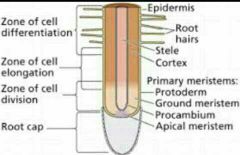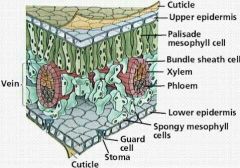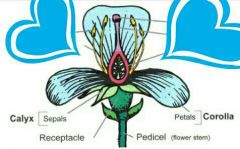![]()
![]()
![]()
Use LEFT and RIGHT arrow keys to navigate between flashcards;
Use UP and DOWN arrow keys to flip the card;
H to show hint;
A reads text to speech;
68 Cards in this Set
- Front
- Back
|
Male gametophyte stage of gymnosperm
|
pollen grain
|
|
|
Cone in which gymnosperm produced in female gametophyte
|
seed cone
|
|
|
Structure found in pairs near the base of each scale on a seed cone
|
ovule
|
|
|
Male cone that produces male gametophytes
|
pollen cone
|
|
|
Contains two haploid sperm cells
|
Pollen tube
|
|
|
Encloses the bud before it opens and protects the developing flower
|
sepals
|
|
|
brightly colored part of a flower that attracts insects
|
petal
|
|
|
produces pollen grains
|
anther
|
|
|
innermost floral part that produces the female gametophytes
|
carpel
|
|
|
flower structure containing one or more ovules
|
ovary
|
|
|
as it grows the seedling is nourished by
|
endosperm
|
|
|
when a corn seedling germinates its cotyledon
|
remains underground
|
|
|
the outer layer of the seed is called
|
the seed coat
|
|
|
an ovary containing angiosperms seed may ripen into
|
a fruit
|
|
|
An embryo is alive but not growing during its period Of
|
dormancy
|
|
|
A single plant can reproduce many offspring genetically identical to itself in the process of
|
Vegetative reproduction
|
|
|
The process in which stems cut from a parent plant are attached to another plant is called
|
grafting
|
|
|
The process in which lateral buds cut from a parent plant are attached to another plant is called
|
Budding
|
|
|
Where does gymnosperm reproduction take place
|
pollen and seed cones
|
|
|
The three principal organs of seed plants are
|
Roots, stem, and leaves
|
|
|
The three type of plant tissues systems are
|
Meristematic dermal and vascular
|
|
|
Two cell types that make up xylem
|
tracheids and vessel elements
|
|
|
Two cell types of makeup for phloem
|
sieve tubes and companion cells
|
|
|
seive tube elements and companion cells are all parts of what
|
Vascular tissue
|
|
|
along a stem leaves and buds are separated by regions of a stem called
|
internode
|
|
|
In a dicot stem parenchyma cells inside the ring of vascular tissue are known as
|
vascular bundles
|
|
|
Primary growth increases what
|
The length of the stem
|
|
|
the increase of width of the stem is what type of growth
|
secondary
|
|
|
The older xylem near the center of a woody stem is
|
Heartwood
|
|
|
Dicots tend to have a thick primary root called
|
taproot
|
|
|
A mature root has a central cylinder of
|
Vascular tissue
|
|
|
The outside layer of a mature root consists of
|
Epidermal cells
|
|
|
The type of tissue in a plant root that separates the central cylinder and the outside layer of cells
|
Ground tissue
|
|
|
The outer layer of a root is
|
Epidermis
|
|
|
The tip of the root is protected by
|
root cap
|
|
|
The innermost part of the root is called
|
The stele or vascular cylinder
|
|
|
The surface area for absorption is tremendously increased by the presence of
|
Root hair
|
|
|
Branch roots grow from the
|
Root hair zone
|
|
|
Two types of protective tissue are
|
Cork and epidermis
|
|
|
Water and minerals are conducted up from the roots to the rest of the plant by the
|
xylem
|
|
|
Food and other dissolved substances are conducted throughout the plant by the
|
Phloem
|
|
|
Where does cell division take place in the root
|
Root cap
|
|
|
What makes up the cortex
|
xylem and phloem
|
|
|
Annual plants survive for
|
One year
|
|
|
Perennials survive for
|
More than two years
|
|
|
The difference between monocots and dicots
|
Monocots are angiosperms with parellel viens whose seed have one cotyledon dicots have branched veins and seeds have to cytoledon
|
|
|
Angiosperms have a what seed
|
enclosed
|
|
|
gymnosperms have
|
a naked seed
|
|
|
What produces new xylem and phloem
|
Meristematic tissue
|
|
|
Cells that divide to increase length of the stem and roots
|
apical stems
|
|
|
cells that increase the plant in width
|
lateral meristem
|
|
|
Where is the photosynthetic tissue of a leaf
|
mesophyll
|
|

|
root
|
|

|
leaf
|
|

|
1 anther
2 filament 3 stigma 4 style 5 ovary |
|
|
type of cell specialized to conduct water
|
trachied
|
|
|
underground stem
|
rhizome
|
|
|
underground organ that exchanges water and .minerals with the environment
|
root
|
|
|
tissue specialized to conduct water and nutrients
|
vascular tissue
|
|
|
photosynthetic organ that contains one or more bundles of vascular tissue
|
leaf
|
|
|
tissue that carries water upward from the roots to other parts of the plant
|
xylem
|
|
|
supporting structure that connects roots and leaves of a plant
|
stem
|
|
|
vascular tissue gathered in leaves
|
vein
|
|
|
coal consists of fossilized remains of
|
club mosses
|
|
|
an increase In the size of the fruit is stimulated by
|
gibberelinns
|
|
|
the group of cells that is located at the petiole and seals off the leaf off from the vascular system In preparation for winter dormacy
|
abscission layer
|
|
|
the desert plant the cactus is also known as
|
xerophyte
|
|
|
a plant that grows directly on the body of another but still produces its own food
|
epiphyte
|

